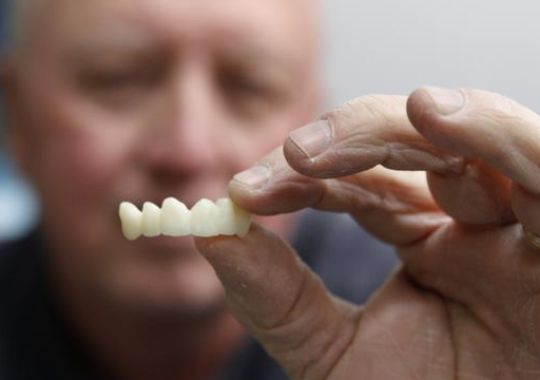Name something you can easily get made for you in an hour:
A pizza? Try half an hour, and that's counting delivery.
Eyeglasses? Easy for places that have their own in-house lab.
A dental crown?
Wielding a 3-D scanner that looked like a bulky electric toothbrush, dentist Randy Raetz spent a few minutes in a patient's mouth one morning last week, getting three-dimensional images of a set of front teeth, the opposing arch, and how they fit together in a bite.
Then, while the patient sat back in the Brighton, N.Y., practice's dental chair and tapped away on his laptop, Raetz tweaked some of the imagery on a computer screen before sending the data to a mill sitting feet away. That mill — about the size of a large breadmaker — drills sugarcube-size porcelain blocks into crowns to be cemented into the patients' mouths.
One visit, a couple of hours, and a patient leaves with a new crown.
"They're doing this kind of stuff as well for braces now," Raetz said.
Alongside the traditional drills, picks and mouth mirrors, 3-D scanners and computer-controlled milling machines machinery — are increasingly becoming commonplace at the dentist's office.
Making digital images of mouths — instead of those gooey, gag-inducing, "bite down on this" molds — and automating the making of dental crowns has been a booming area of dentistry in recent years, said Carlo Ercoli, chairman of the prosthodontic postgraduate training program at the University of Rochester's Eastman Institute for Oral Health.
And increasingly, patients are coming to expect it, Ercoli said: "The wow factor' is the patient coming in and saying, 'Ooh, look at all these state-of-the-art instruments that this person has.' (Without them), you might say, 'Is this guy up to date?'"
The technology also brings work in-house that dentists traditionally have sent out to dental technologist labs, such as the fabrication of crowns or dentures. And this gear, such as automated mills that use computer-controlled drill bits to grind out crowns, has already been hugely incorporated by dental technologists into their labs, Ercoli said.
Meanwhile, 3-D printing is getting a toehold into the dental world as well with a growing number of companies working on implants by zapping liquid plastic with a laser, quickly hardening it layer by layer into a dental prosthetic, Ercoli said. That technology is more at its infancy stage compared with subtractive 3-D printing, involving mills grinding out caps out of blocks of plastic or porcelain.
Here's how getting a tooth capped traditionally has worked: The patient would get numbed up, and an impression would be made of the tooth. While the information was sent off to a lab for fabrication of that cap, a temporary crown was put in place. Then the patient went home and had to be careful around the temporary as they had a tendency to come off, which would entail returning to the dentist to get the temporary put back. After a couple of weeks, the patient returned for the permanent crown to be cemented in place.
For dentists and patients, the ability to have a crown whipped up by a machine in the time it takes for a rice cooker to work is a major improvement in productivity, said Cheryl Brunelle, whose Lilac Family Dental practice in East Rochester has installed a PlanScan system made by E4D Technologies, one of an array of digital dental companies.
"People are busy, they don't want to come back multiple times," Brunelle said. "Some people have a really strong gag reflex and cannot tolerate impressions at all. It's also nicer for the tooth itself. By that second appointment of having to take the temporary off, it gets more traumatic than finishing it in one appointment. A lot of times if you have to go back in it irritates the tooth that much more."
Added Brunelle: "It also saves us time. If we can get a visit done in one versus two vists, it's a lot easier for us as well."
While the mill can grind out a tooth, it still requires human input on making it look like a real tooth, such as using various tints to approximate the shading and marbling.
"A tooth is not just white," Ercoli said. "If I make a tooth totally white, you'll probably sue me — totally unaesthetic. A tooth has much more aesthetic details. The machine doesn't have the ability yet — yet — to do it.
Such investments don't come cheap. A set-up like Raetz's — a PlanScan scanner wand and mill, as well as a small kiln for treating the tooth — can cost close to $100,000, according to Henry Schein, a distributor of medical and dental supplies and equipment, including PlanScan gear.
Meanwhile, as the technology becomes more ubiquitous in dental practices, dental schools are adding it to their classrooms.
Rochester's Eastman Institute for Oral Health last year finished a $1.3 million renovation of its prosthodontic clinic that included adding a variety of digital technology. While it teaches a course now on taking impressions digitally, Eastman is hoping to expand its digital dentistry program to offer exposure to more types of equipment, Ercoli said.
Raetz's PlanScan wand is actually the third such digital scanner his practice has added over the past half-dozen years — the first being a bulky and heavy wheeled cart, then a smaller and more maneuverable cart, and now the wand. And when his practice went digital, Raetz said, learning how to do that scanning well was the biggest part of the learning curve.
"Everything else is cake," he said. "Really easy."
Daneman also reports for the Rochester (N.Y.) Democrat and Chronicle


